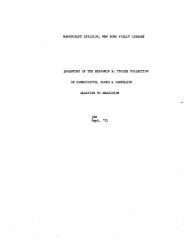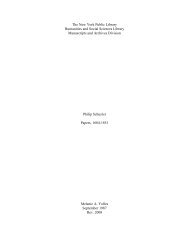pdf available - Multiple Choices
pdf available - Multiple Choices
pdf available - Multiple Choices
You also want an ePaper? Increase the reach of your titles
YUMPU automatically turns print PDFs into web optimized ePapers that Google loves.
ments from the Temple [in Jerusalem]. And more<br />
beautiful than all the restthe doors to the Holy<br />
Ark, whose decorations reached all the way to the<br />
ceiling.<br />
We were also proud and boasted about the<br />
beautiful lectern (balemer) in the center of the<br />
synagogue. Its four carved hexagonal pillars<br />
reached upwards to the domed ceiling, and from<br />
it copper chains descended, with huge crystal<br />
chandeliers that flickered in a rainbow of colors.<br />
It was an impressive sight when a procession of<br />
Torahs ascended the stairs to the high lectern as<br />
the entire congregation stood by.<br />
The walls and high arching windows on three<br />
sides also made a special impression. We were<br />
amazed by the force of the acoustics in the synagogue,<br />
and when we had a chance to remain there<br />
alone we would shout and wait excitedly for the<br />
echo that came to us from all directions.<br />
On the other hand, we were afraid to pass<br />
close to the synagogue alone at nightthe "time<br />
when the souls of the departed came to the<br />
synagogue for prayer and the reading of the<br />
Torah."<br />
The Surroundings<br />
The city was located on a broad flat plain, which<br />
spread out for miles and was covered by thick<br />
forests of pine and fir trees in the areas where the<br />
ground was lighter and sandier, and birch trees,<br />
beeches, ashes, poplars, and oaks in heavier,<br />
damper ground. Brooks and lakes filled with<br />
various sorts of fish, among them the famous Lake<br />
Shvitazh, were spread out along the northern and<br />
northwestern segments of the area, bordering on<br />
the swamps and forests of Polesia (southwestern<br />
Belorussia). About 7 to 9 miles from the city, the<br />
river Bug meandered, forming the border between<br />
western Ukraine and Poland.<br />
Most of the soil in the area was thin and light,<br />
which mainly supported the growth of rye, barley,<br />
spelt, millet, and potatoes, and of course, there<br />
was abundant pasture land. There was very little<br />
heavier, richer soil on which wheat, flax, oats,<br />
and other crops grew. In a few places there were<br />
orchards of fruit trees, especially apples, plums,<br />
and pears. The city itself excelled in a great<br />
number of gardens with fruit trees, a few belonging<br />
to Jews, most of them to the residents of the<br />
THE EARLY DAYS 47<br />
suburbs, non-Jews. Especially worthy of praise<br />
was the large garden owned by Kampyoni, which<br />
stretched out over a considerable area of the<br />
eastern part of town.<br />
On the southern edge of town ran the railroad<br />
tracks that were a direct connection between east<br />
and west, from Kiev through Zdolbunov, Rovno,<br />
Kovel, and other towns in the east, and to Chelm,<br />
Lublin, and Warsaw in the west.<br />
On that same side, south of the city, an old<br />
dirt road led south to Vladimir Volinsk (Ludmir),<br />
a distance of 60-65 versts (about 40-43 miles);<br />
on the western edge ran the strategic road that<br />
was paved, it appears, at the end of the previous<br />
century, leading to Brisk of Lithuania (Brest-<br />
Litovsk), 85 miles to the north. Roads wound<br />
from all entrances to the cityall of them wide,<br />
dirt roads, with acacias, plane trees, and willows<br />
growing alongsideand led to the adjacent small<br />
towns and villages.<br />
Streets and Ditches<br />
Though the city itself sits on high ground, during<br />
the rainy season it would drown in sinking mud,<br />
which made travel difficult both for pedestrians<br />
and vehicular trafficthe wagon, of course.<br />
Crossing from house to house and street to<br />
street was accomplished by walking over thin<br />
wooden planks (briklach)stretched out the entire<br />
length of the main streets on both sides. Underneath<br />
were the trenches, for sewage and rainfall,<br />
connected with the main, large drainage ditches<br />
that drew off water to the outskirts of the city.<br />
Those who lived in the low-lying areas had<br />
it particularly hardthe area around the bathhouse<br />
and alleyway of the butcher shops. During<br />
the rainy season the connection with villagesthe<br />
major source of livelihoodwas greatly weakened<br />
or cut off altogether and the townspeople,<br />
who walked around with nothing to do, prayed<br />
and anxiously awaited an improvement in the<br />
weather.<br />
During the First World War an attempt was<br />
made to pave the road with wooden planks by the<br />
Austro-German conquerors, employing refugees<br />
from other occupied territories. This attempt was<br />
halted immediately at the end of the war. In<br />
1919-20, the first roads were paved with crushed<br />
stone in the main thoroughfares of the town.







